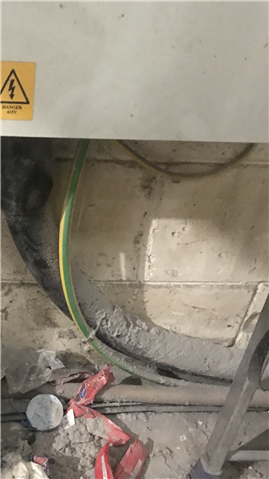According to regulation 422.3.9 what kind of electrical protection is needed for paper recycling plants, which are characterised by high levels of dust? Does the regulation apply to final circuits or the distribution circuits of the facilities?
AMK,
If there are high levels of dust as you indicated. Has somebody carried out a DSEAR Risk assessment with regards the combustable nature of the dust? e.g. is it conductive dust?, what is the particle size? expected and accepted depth of dust that may gather on any electrical equipment? So depending on that risk assessmnet the selection, design and installation methods may have to comply with BSEN 60079-14. Im sure the duty holder will already have considered this but if dust is present then people may be breathing it in, so appropriate PPE will be required.
There are many installations/facilities in the UK where dust is produced/present but many fail to take into account is combustible and explosive nature if a dust cloud is ignited.
Cheers GTB

Thank you Lyledunn & GTB. This is a photo of how much paper dust has accumulated on the SWA cable. The main baler and shredder of the plant have a fire suppression system above them. However, there are high levels of dust on the isolators and cables.
what appeared to be reasonable IP protection
The test for IP5x and IP6x uses talcum powder that might have a diameter of up to 75 microns. HEPA filters (to European standards) to reduce risks associated with harmful and explosive dusts typically filter out 99.95 % of particles down to 0.3 microns.
Explosive atmospheres are specifically outside the scope of BS EN 60529 - so the examples of paper and coal dust are particularly interesting in this regard. Basically, it implies that selection of IP rating alone is insufficient to manage the risks.
Graham,
I totally agree with your thoughts. Across the UK in general many Duty Holders fail to recognise all the risks of combustable dust.
AMK's client should really to satisfy DSEAR 2002, take samples of the Paper "Dust" at diffrent locations in the building, or on process equipment, enclosures etc. Then have the "Dust" analysed for the average particle size, so typically below 500MicroMetres its classed as Dust, greater than 500MicroMetres its an industrial flying. Although paper shouldnt be, but get a electrical resitivity test done on the "Dust" anyway to ensure its non conductive or not. Then from those results things can move on with regards potential combustable atmospheres. Im sure Fire risk assessment also important in this facility.
Obviously the "Paper" from one industry to another can all be diffrent, but from info I have here to hand the ignition energy of a paper dust cloud is approx 20mJ. The ignition temperature being circa 580 Deg C for a dust cloud and circa 360 Deg C for the ignition temp of a paper dust layer up to 5mm thick.
The photo shows dust gathering on the sheath of the armour, but how much dust is gathering on all horizontal surfaces in that workplace? on structural beams, or worse if they have any kind of ceiling, do they have ventilation systems etc.
As we know from dust explosions we have two events the primary which may not be catastrophic, but the secondary likley will be.
Always a saying I remember from my very first combustable dust course. " NO DUST NO Danger" !!
Cheers GTB
I agree that the risks associated with combustible dust are often not recognised or are poorly understood in industry.
I would reccomend anyone with an interest in the subject obtains a copy of HSE Publication HSG103 - Safe Handling of Combustible Dusts, which can be downloaded from the HSE website and which is a good introduction to the subject.
Some of the most seemingly innocuous dusts can be dangerous - the above publication gives an example of an explosion in the UK that injured nine people, where the combustible dust involved was custard powder (!).
Almost any combustible dust will explode if is dispersed to form a mixture with air above the minimum explosible concentration for that dust and is exposed to source of ignition above the minimum ignition energy for that dust.
The minimum explosible concentration for most common dusts are in the the order of tens of grams per cubic metre, concentrations which are only likely to occur within process plant.
However, an primary explosion occuring within process plant may then disturb accumulations of combustible dust (as mentioned by GTB above) elsewhere in the workplace, leading to the formation of a much larger explosible dust cloud, its subsequent ignition and a much larger secondary explosion.
An example of this is the explosion at West Pharmaceutical Services in the US in 2003, where up to one ton of polyethylene (polymer) dust that had accumulated above a suspended ceiling in a manufacturing area was disturbed, forming an explosible dust cloud that subsequently ignited, causing an explosion that killed six people and injured thirty-eight others.
The full investigation report and a summary of the West Pharmaceutical Services explosion are available from the US Chemical Safety Board website and would again be recommended reading for anyone with an interest in the subject of dust explosions.
Best Regards,
Ross
We're about to take you to the IET registration website. Don't worry though, you'll be sent straight back to the community after completing the registration.
Continue to the IET registration site